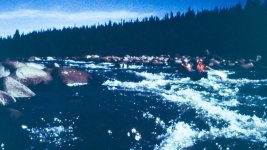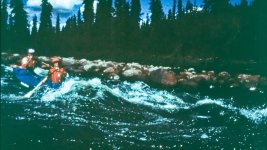The best thing Kathleen and I ever did soon after buying our first canoe was to join the Beaver Canoe Club in the Vancouver, BC area. The club scheduled a Sunday paddle, pretty much year-round, primarily on whitewater, usually including some Class II Or low Class III. This gave us weekly leadership, demonstration and instruction from very experienced and skilled whitewater paddlers. We also took a course at a local community college, again with a focus on whitewater. I also took a course in northern BC, again with a focus on whitewater, specifically Class III. The instructor filmed us doing our various moves, which was very revealing, as we often were not performing as we thought. As an aside, on one of our club trips, a new paddler showed up, and joined the group Kathleen and I were leading. He said he was a pretty good paddler, as he had watched all the Bill Mason videos many times. Turns out that watching videos doesn’t translate directly into paddling like Bill Mason.
Kathleen and I pretty much practiced every week, always pushing ourselves, as we wanted to paddle far northern rivers and rapids with confidence. On these northern trips, we generally paddled to our known limits, even with our boat fully loaded with 3-5 weeks of food and gear. I think virtually everyone can benefit from professional, qualified instruction. My feeling is that most of us have less than excellent skills. That means, not knowing how we could improve, the more we practice and paddle, the more we perfect our mediocre techniques.
Our first wilderness trip was on the South Nahanni River in the Northwest Territories. We began at the Moose Ponds, just above the stretch known as the Rock Gardens, two-and-half days of pretty much continuous whitewater, rated to Class III and IV.

Here we are on the first day in the Rock Gardens. I had become pretty confident with my high brace, sometimes claiming, incorrectly, that I could never capsize away from my paddle side. Kathleen had become darn good with her low brace. We were a good pair. (Photo by Robson/Power)

Still in the Rock Gardens. Looks like Kathleen is drawing right. I am probably getting ready for a forward stroke. We had often been instructed, even when uncertain what to do, to just go forward somewhere, which is almost always better that just sitting there, letting the river take over. On day trips with our Beaver Canoe Club, we would often surf/ferry across rivers in troughs like this. If you hit the trough just right, with lots of momentum, you could get across the river with just one, good, powerful forward stroke. (Photo by Robson/Power).
As has been suggested in previous posts, we are all capable on flat water and Class I or II, at getting the canoe to go pretty much where we want. But seeing on a weekly basis, what a few other paddlers could do, Kathleen and I wanted much more. Instruction provided that, and allowed us to paddle rapids on northern wilderness rivers with confidence and success. In fact we have never capsized.


